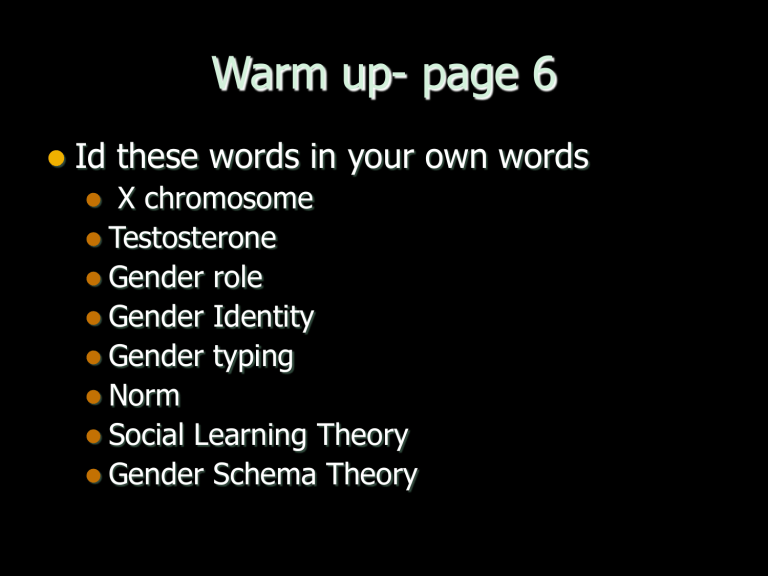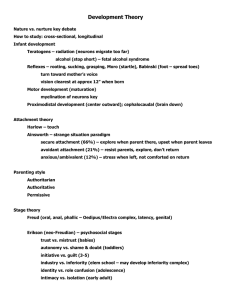Warm up- page 6 Id these words in your own words

Warm up- page 6
Id these words in your own words
X chromosome
Testosterone
Gender role
Gender Identity
Gender typing
Norm
Social Learning Theory
Gender Schema Theory
Chapter 4: Developmental
Psychology pt. 1
Developmental Psychology
Branch of psychology that studies physical, cognitive, and social changes through out the life span.
Look for commonalities between us.
Look at issues of:
Nature/nurture
Continuity/Stages
Stability/Change
Prenatal Development
Zygote: fertilized egg…eventually develops into a embryo after 2 weeks.
Cells rapidly start dividing to create a multicellular organism and differentiate to create organs.
Fewer than half survive to become embryos.
Prenatal Development
Embryo: developing human organism.
Considered embryo from
2 weeks to 2 nd month.
This stage is when pregnancy is officially established…woman will miss period.
Week 4-8 are when all major organs begin functioning.
When teratogens have greatest effect.
Prenatal Development
Fetus: developing human organism from 9 weeks after conception until birth.
After 12 weeks most of major development is
“finished” except for brain and lungs.
Responsive to sound
After 6 months…premature babies’ organs sufficiently formed to allow chance of survival.
Week 16
Week 20
Teratogens
Agents such as chemicals and viruses that can reach the embryo or fetus during prenatal development and cause harm.
Examples: AIDS virus, drugs, alcohol can all be passed onto baby and cause damage.
Fetal Alcohol
Syndrome
Fetal Alcohol Syndrome
No safe amount of alcohol
1 in 750 infants
Small, misproportioned head, brain abnormalities
Leading cause of mental retardation
Newborn Capacities
Come equipped with reflexes ideally suited for survival. Ex: rooting reflex: baby’s tendency when touched on the cheek to open the mouth and search for food.
Newborn Capacities
Habituation: describes infants’ decreasing responsiveness to repeated stimuli.
Infer that newborns have cognitive ability to differentiate between different visual stimuli.
Maturation
Biological growth processes that enable orderly changes in behavior, relatively uninfluenced by experience.
Genetic blueprint unfolding
Stand before walking
In terms of brain development, natural maturation causes neural interconnection to multiply rapidly after birth.
However, severe deprivation and abuse will retard development. Furthermore, increased stimulation will cause early neural connections.
Maturation sets the basic course of development; experience adjusts it.
Maturation and Memory
Earliest memory is hardly before age 3
After age ¾ we organize memories different
Normal Maturation
Maturation and Motor Skills
Maturation also influences motor development.
The sequence of complex physical skills, from sitting, standing, walking, are nearly universal are across the world.
Overall, experience has a limited effect until certain muscular or neural maturation occurs. Ex: Potty Training.
Cognitive Development
Developed stages of cognitive development
Jean Piaget
Mental activities associated with thinking, knowing, remembering and communicating
Schemas: concepts of phenomena developed by humans that increase with development. Adjusted by:
Assimilation: interpreting one’s new experience in terms of one’s existing schemas. Ex: kids and “doggies”
Accommodation: adapting one’s current understandings (schemas) to incorporate new information. Ex: new schema for groundhog.
Know This Chart
Piaget’s Stages
Stage 1: Sensorimotor: birth to 2, experience world mostly through your senses and movement.
Major Development During this stage:
A.
B.
Stranger Anxiety
Object Permanence: awareness that things continue to exist even when not perceived.
Why Babies like peek-a-boo.
Piaget’s Stages
Stage 2: Preoperational: 2-6, child learns to represent things with language but does not understand concrete logic.
Major Development During this stage:
1.
Pretend Play
2.
3.
Language Development
Egocentrism: inability to take another point of view.
Theory Of Mind
Although still egocentric they begin to form a theory of mind
Realizing that people have minds and think
Ask Why?
Begin to empathize,tease, take another perspective
Autism
A disorder characterized by deficient communication and social interaction
Lev Vygotsky
Age 7 children no longer need to always think out loud
Pre operational and operational
Use inner speech
Piaget’s Stages
child begins to think concretely and complete math operations.
Major Development During this Stage:
1. Conservation: principle that mass, volume, and number remain the same despite their form.
Piaget’s Stages
Stage 4: Formal Operational:
12 to adulthood, ability to abstractly reason and use abstract logic.
Major Developments During This
Stage:
1.
Abstract Logic: hypothetical situations, ideas like communism
2.
Mature Moral Reasoning: ideas like “right to life,” “right to liberty,” Etc.
Current Thinking
Piaget’s sequence is right but timing is not exact.
Some cognitive events occur earlier than he thought and process as a whole is more continuous.
Did not give children enough credit
Warm up
pick up warm up off of the overhead. Work in groups to complete it
All work must be complete in 10 minuets
Social Development
Attachment
Emotional tie with
another person; shown in young children by their seeking closeness to the caregiver and showing distress on
separation.
Harlow’s Theory of Attachment
Attachment is based on:
1.
2.
3.
Body Contact
Familiarity
Responsive
Parenting
Body Contact
Infants become intensely attached to entitities that provide comfortable body
contact to them. Things like rocking, warmth, and feeding make attachment stronger.
IMPORTANCE: NOT nourishment that provides attachment as originally thought.
Familiarity
Also key in understanding attachment.
A.) Critical Period: optimal period shortly after birth when certain events must take
place to facilitate proper development.
Ex: First moving object a duckling sees it will attach to as its mother…would follow person, moving ball, etc.
B.) Imprinting: process by which certain animals form attachments during a critical
period very early in life. NOT FOR
HUMANS. However do become attached to what they know.
Responsive Parenting
Responsive Parenting leads to secure attachment.
Secure Attachment: in mother’s presence will explore new territories and play
comfortably. When mother leaves will become distressed, when returns will seek contact with her.
60 % of all infants
Responsive Parenting
Insecure
Attachment: in mother’s presence are less likely to explore
their surroundings; cling to mother. When leaves, cry loudly and remain upset or
seem indifferent to their mother’s comings and goings.
Why Secure or Insecure
Mary Ainsworth
Studied 1 year olds in “ strange situations ” without mothers
Found- sensitive, responsive mothers had secure children
Found- insensitive, unresponsive
mothers, mothers who respond when convenient, had insecurely attached children
Secure Attachment predicts social competency
Securely attached children approach life with basic trust
A sense that the world is predictable and reliable
Attachment also reflects romance styles
Consequences of Insecure
Attachment
Under conditions of abuse and neglect, humans are often withdrawn, frightened, even speechless.
Harlow’s monkeys often incapable of mating or extremely abusive, neglectful, or
murderous towards first-born.
Most abusers were abused; abused are
more likely to abuse…even though the majority of them don’t.
Disruption of Attachment
Separation from loved ones can have devastating results
If removed and placed in a more
stable environment most effects of the separation disappear
Adults also suffer when attachment bonds are severed
Daycare and Attachment
Children need consistent, warm relationships with people they can trust
Daycare has both good and bad effects
Self –Concept
Self- Concept- a sense of their own identity and personal worth
Develops by age 12
The next big step after attachment
Parental Authority Questionnaire
1. Permissive- relatively warm, non demanding, noncontrolling parent
#s- 1,6,10,13,14,17,19,21,24,28
2. Authoritarian- parents who value unquestioning obedience and attempt to control their children’s behaviors, often through punitive disciplinary practices
#’s- 2,3,7,9,12,16,18,25,26,29
3. Authoritative- parents who use firm ,clear but flexible and rational modes of child rearing
#’s- 4,5,8,11,15,20,22,23,27,30
4. Total them up
Social Development: Child Rearing
Practices- Baumrind
Authoritarian
parents impose rules and expect obedience
“Don’t interrupt”
“Why? Because I said so.”
Permissive:
submit to children’s desires
make few demands
use little punishment
Social Development-
Child-Rearing Practices
Authoritative
parents are both demanding and responsive
set rules, but explain reasons
encourage discussion
Children have highest self esteem and social competence
Rejecting-neglecting
disengaged
expect little
invest little
